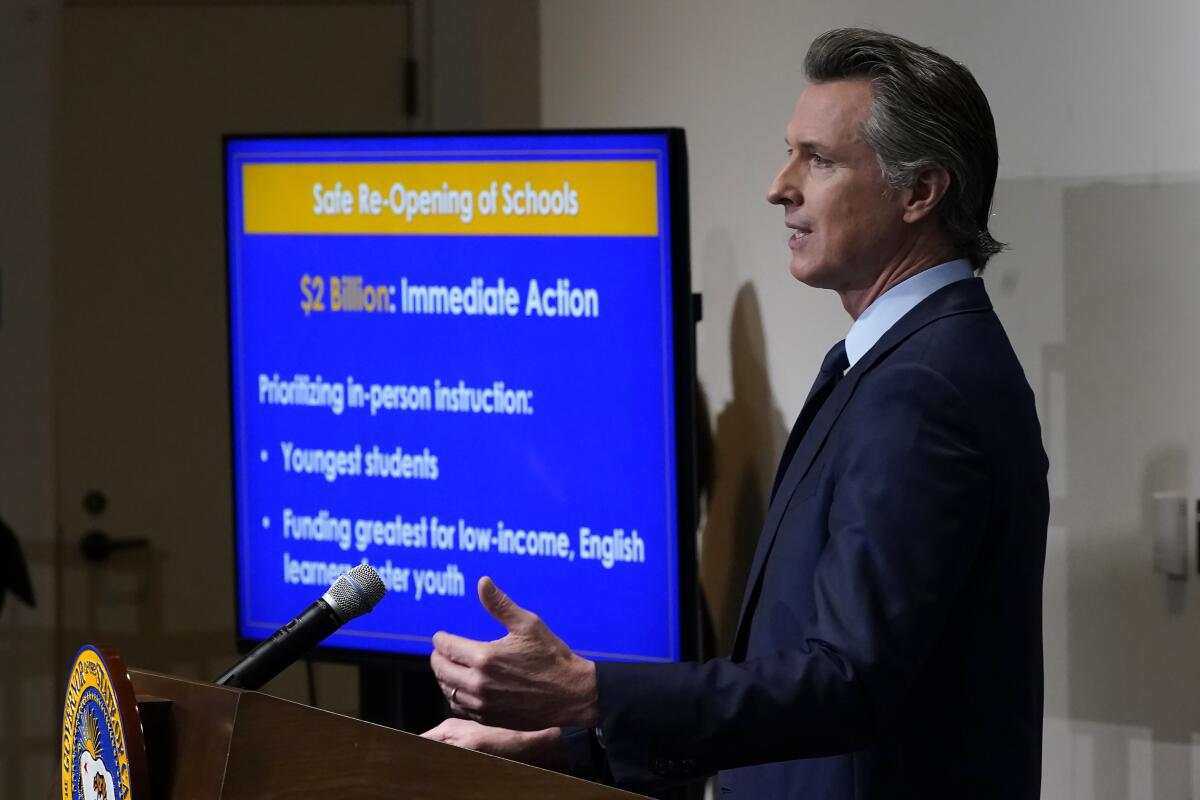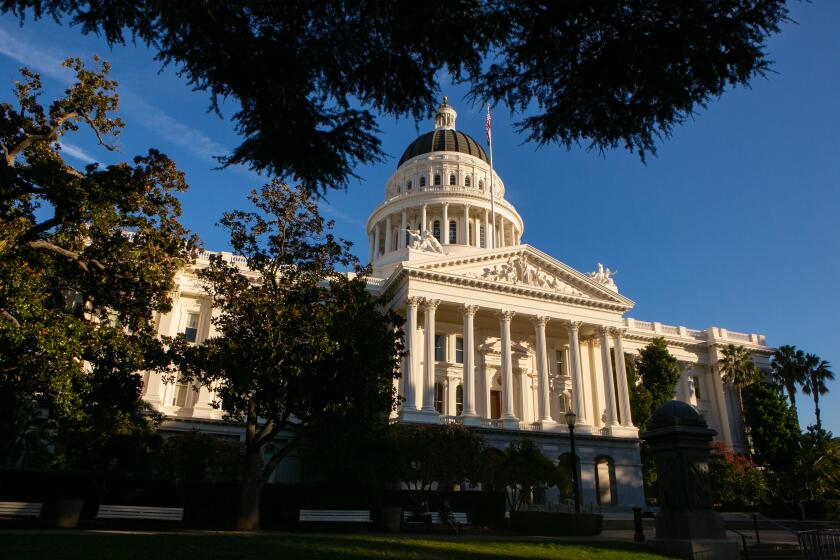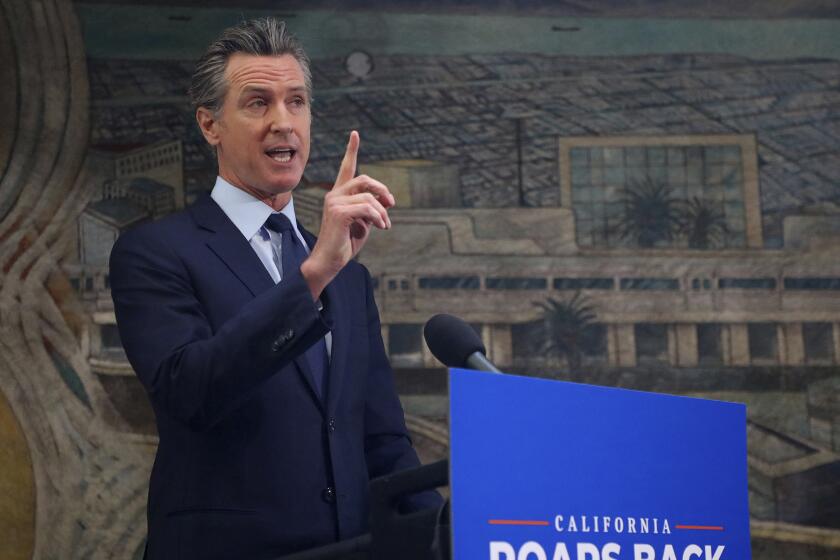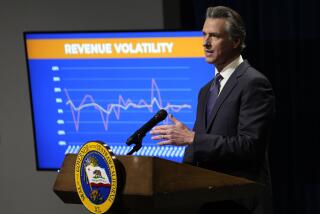California is projected to have another big budget surplus. Here’s how Newsom should use it

- Share via
SACRAMENTO — Gov. Gavin Newsom has billions to be grateful for this Thanksgiving — an unexpected $31 billion to buy gifts for voters.
Independent Legislative Analyst Gabriel Petek calculated that figure last week but cautioned he could be way off. The actual state budget surplus could range from $60 billion down to $10 billion, he reported.
The $31-billion projection, however, “is more than reasonable,” says state finance department spokesman H.D. Palmer.
Whatever the size, it’s a bundle the governor and Legislature hadn’t anticipated when they crafted the current $263-billion budget in June.
The spare money is on top of the $76-billion windfall they had then. And Newsom enjoyed a $22-billion surplus his first year as governor in 2019.
Tax “revenues are growing at historic rates,” Petek wrote.
All kinds of revenues — income, corporate, sales.
“Underlying this growth is a meteoric rise in several measures of economic activity,” Petek reported.
“Retail sales have posted double-digit growth during 2021. Stock prices have doubled from the pandemic low last spring. Several major firms have posted historically high earnings….
“Tax revenues … are higher by nearly $28 billion … compared to budget act estimates.”
Sacramento has been raking in so much tax money that it has reached its constitutional spending limit. So, Petek anticipates there’ll be restrictions on $26 billion of the extra money — $14 billion during the current fiscal year and $12 billion in the budget year beginning next July.
California’s constitutional cap on state spending is likely to dictate how lawmakers divvy up almost all of a $31-billion tax surplus, analysts say.
Skelton: Newsom gets to play Santa Claus to California voters while Gray Davis was the grinch
Newsom has been traveling around California making expensive promises to voters who very likely will be deciding in a fall recall election whether to keep or toss him, columnist George Skelton writes.
That’s because of Proposition 4, the so-called Gann Limit, approved overwhelmingly by voters in 1979. Californians were on a tax-cutting crusade. It was one year after the landslide passage of Proposition 13, the landmark property tax-cutting initiative. Paul Gann was a Proposition 13 co-sponsor with Howard Jarvis.
Under the Gann measure — officially called the State Appropriations Limit — Sacramento spending was limited by inflation and population growth. Until recently, inflation was low. Population is stagnant.
The original act decreed that if the limit was reached, the surplus money had to “be returned” to taxpayers “by a revision of tax rates or fee schedules.” The law was later amended to split the surplus 50-50 between taxpayers and schools.
Under the law’s current interpretation, the excess revenue can be used three ways:
1. Taxes can be cut. What a concept!
2. The money can be split between taxpayer rebates and K-14 schools.
3. It can be spent on such things as public works projects, local government aid, paying off debt and emergencies.
Only once before has the Gann Limit been reached. In 1987, Republican Gov. George Deukmejian and the Democrat-controlled Legislature compromised on small rebates.
Single people got checks of at least $32 and couples received $64. Above that, people got rebates based on the income taxes they’d paid, up to a maximum of $118 for a single person and $236 for a couple.
There was something for everyone — unlike what Newsom is contemplating now. Democratic leaders objected back then, but there was a Republican governor — a world of difference from today’s one-party rule in Sacramento.
There’ll probably be a so-called rebate next year, but not one befitting the spirit of the Gann Limit that voters embraced. A rebate is when you buy something or pay a tax and get back a portion. What Newsom calls a rebate is really a social spending program.
Newsom indicated last week that he intends to model the rebate after what he and the Legislature enacted in June that benefited only people making less than $75,000 a year.
First, $600 payments that Newsom called Golden State Stimulus were made to taxpayers who earned less than $30,000. Later, $600 checks went to those making between $30,000 and $75,000.
Those earning less than $75,000 with dependents got an additional $500. Immigrants in the country illegally with a dependent received $500 on top of that for a total of $1,000. Why?
“They live here. They contribute to the California economy and society. And they were not eligible for any comparable federal assistance,” Palmer says.
I’m not arguing against the policy — or for it — just pointing out that to call it a rebate is verbal butchery. The highest-income taxpayers who built the lion’s share of the surplus didn’t get back a dime.
The top 20% of taxpayers pay 89% of the state income tax, based on 2019 data, the latest available. And they didn’t get any of their taxes rebated.
The personal income tax supplies two-thirds of the state General Fund revenue.
Newsom was asked at a news conference how he intends to handle the new excess tax revenue.
“You saw a preview of that last year,” the governor replied, referring to the last budget enactment. “We had the largest tax rebate of any state in U.S. history — $12 billion.”
Newsom also pointed out that the gargantuan surplus was used to beef up reserve funds, reduce pension obligations, help small businesses, double earned income tax credits for poor people, expand child care and generally strengthen the social safety net.
“That’s the approach,” he continued. “Fiscally disciplined … recognizing the one-time nature of most of these dollars … so that we’re not caught flat-footed when the economy contracts, when the markets begin to adjust, when we try to tame this beast called inflation.”
Here’s a suggestion: Use most of the windfall to pay cash for public works rather than borrowing.
Purchase badly needed wildfire fighting equipment. These smoky, blazing summers are unacceptable.
Invest in water facilities, including desalination, and clean up aquifers.
Build housing for homeless people.
Another idea: Suspend auto registration fees to help compensate for exorbitant gas prices.
Every taxpayer deserves to share in the bonanza.
More to Read
Sign up for Essential California
The most important California stories and recommendations in your inbox every morning.
You may occasionally receive promotional content from the Los Angeles Times.













